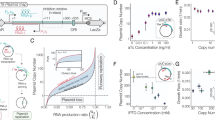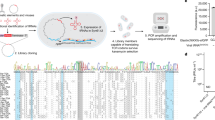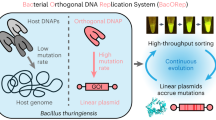Abstract
The valS-system for plasmid stabilization involves cloning the wild–type gene for valyl–tRNA synthetase (valS) in a plasmid which is transformed into a host strain carrying a temperature–sensitive mutation in its chromosomal valS–gene. At the non–permissive temperature cell growth is de pendent on the plasmid–encoded wild–type enzyme. Partition (par) loci from R1 or pSC101 plasmids did not stabilize plasmid inheritance. Although both par loci stabilized segregation somewhat, by 75–100 generations plasmids were lost from the majority of the cells. In contrast, in heritance of the plasmid was stabilized with the valS system for at least 150 generations.
This is a preview of subscription content, access via your institution
Access options
Subscribe to this journal
Receive 12 print issues and online access
$209.00 per year
only $17.42 per issue
Buy this article
- Purchase on Springer Link
- Instant access to full article PDF
Prices may be subject to local taxes which are calculated during checkout
Similar content being viewed by others
References
Cohen, S.N., Chang, A.C.Y., Boyer, H.W., and Helling, R.B. 1973. Construction of biologically functional bacterial plasmids in vitro. Proc. Natl. Acad. Sci. U.S.A. 70:3240–3244.
Nugent, M.E., Primrose, S.B., and Tacon, W.C.A. 1983. The stability of recombinant DNA, p. 271–285. In: Developments in Industrial Microbiology. Vol. 24. Proceedings of the Thirty-Ninth General Meeting of the Society for Industrial Microbiology. Arlington, Virginia.
Rood, J.I., Sneddon, M.K., and Morrison, J.F. 1980. Instability in tyrR strains of plasmids carrying the tyrosine operon: isolation and characterization of plasmid derivatives with insertions or deletions. J. Bacteriol. 144:552–559.
Tsunekawa, H., Tateishi, M., Imanaka, T., and Aiba, S. 1981. TnA-directed deletion of the trp operon from RSF2124-trp in Escherichia coli. J. Gen. Microbiol. 127:93–102.
Skogman, S.G., Nilsson, J., and Gustafsson, P. 1983. The use of a partition locus to increase stability of tryptophan-operon-bearing plasmids in Escherichia coli. Gene 23:105–115.
Imanaka, T., Tsunekawa, H., and Aiba, S. 1980. Phenotypic stability of trp operon recombinant plasmids in Escherichia coli. J. Gen. Microbiol. 118:253–261.
Miwa, K., Nakamori, S., Sano, K., and Momose, H. 1984. Stability of recombinant plasmids carrying the threonine operon in Escherichia coli. Agric. Biol. Chem. 48:2233–2237.
Rosteck Jr., P.R., and Hershberger, C.L. 1983. Selective retention of recombinant plasmids coding for human insulin. Gene 25:29–38.
Meacock, P.A., and Cohen, S.N. 1980. Partitioning of bacterial plasmids during cell division: a cis-acting locus that acomplishes stable plasmid inheritance. Cell 20:529–542.
Miki, T., Easton, A.M., and Rownd, R.H. 1980. Cloning of replication, incompatibility, and stability functions of R plasmid NR1. J. Bacteriol. 141:87–99.
Nordström, K., Molin, S., and Aagaard-Hansen, H. 1980, Partitioning of plasmid R1 in Escherichia coli. I. Kinetics of loss of plasmid derivatives deleted of the par region. Plasmid 4:215–227.
Ogura, T., and Hiraga, S. 1983. Partition mechanism of F plasmid: Two plasmid gene-encoded products and a cis-acting region are involved in partition. Cell 32:351–360.
Austin, S., and Abeles, A. 1983. The partition of unit-copy miniplasmids to daughter cells. I. P1 and F miniplasmids contain discrete, interchangeable sequences sufficient to promote equipartition. J. Mol. Biol. 169:353–372.
Summers, D.K., and Sherratt, D.J. 1984. Multimerization of high copy number plasmids causes instability: Col E1 encodes a determinant essential for plasmid monomerization and stability. Cell 36:1097–1103.
Skogman, S.G., and Nilsson, J. 1984. Temperature-dependent retention of a tryptophan-operon-bearing plasmid in Escherichia coli. Gene 31:117–122.
Gerdes, K., Larsen, J.E.L., and Molin, S. 1985. Stable inheritance of plasmid R1 requires two different loci. J. Bacteriol. 161:292–298.
Primrose, S.B., Derbyshire, P., Jones, I.M., Robinson, A., and Ellwood, D.C. 1984. The application of continuous culture to the study of plasmid stability, p. 213–238. In: Continuous culture 8/: Biotechnol., Med. Environ. Dean, A. C. R. (ed.) London
Zurita, M., Bolivar, F., and Soberón, X. 1984. Construction and characterization of new cloning vehicles. VII. Construction of plasmid pBR327 par, a completely sequenced, stable derivative of pBR327 containing the par locus of pSC101. Gene 28:119–122.
Melling, J., Ellwood, D.C., and Robinson, A. 1977. Survival of R-factor carrying Escherichia coli in mixed cultures in the chemostat. FEMS Microbiol. Letters 2:87–89.
Wouters, J.T.M., and van Andel, J.G., 1983. Persistence of the R6 Plasmid in Escherichia coli grown in chemostat cultures. FEMS Microbiol. Lett. 16:169–174.
Edlin, G., Tait, R.C., and Rodriguez, R.L. 1984. A bacteriophage λ cohesive ends (cos) DNA fragment enhances the fitness of plasmid-containing bacteria growing in energy-limited chemostats. Bio/Technology 2:251–254.
Ferrari, E., Henner, D.J., and Yang, M.Y. 1985. Isolation of an alanine racemase gene from Bacillus subtilis and its use for plasmid maintenance in B. subtilis. Bio/Technology 3:1003–1007.
Bertani, G. 1951. Studies on lysogenesis. I. The mode of phage liberation by lysogenic Escherichia coli. J. Bacteriol. 62:293–300.
Vogel, H.J., and Bonner, D.M. 1956. Acetylornithinase of Escherichia coli: Partial purification and some properties. J. Biol. Chem. 218:97–106.
Engel-Valk, B.E., Heyneker, H.L., Oosterbaan, R.A., and Pouwels, P.H. 1980. Construction of new cloning vehicles with genes of the tryptophan operon of Escherichia coli as genetic markers. Gene 9:69–85.
Tingle, M.A., and Neidhardt, F.C. 1969. Mapping of a structural gene for valyl-transfer ribonucleic acid synthetase in Escherichia coli by transduction. J. Bacteriol. 98:837–839.
Ream, L.W., Margossian, L., Clark, A.J., Hanson, F.G., and von Meyerburg, K. 1980. Genetic and physical mapping of recF in Escherichia coli K-12. Molec. Gen. Genet. 180:115–121.
Björk, G.R., and Olsén, A. 1979. A method for isolation of Escherichia coli mutants with aberrant RNA methylation using translocatable drug resistance elements. Acta Chem. Scand. B 33:591–593.
Author information
Authors and Affiliations
Rights and permissions
About this article
Cite this article
Nilsson, J., Skogman, S. Stabilization of Escherichia coli Tryptophan–Production Vectors in Continuous Cultures: A Comparison of Three Different Systems. Nat Biotechnol 4, 901–903 (1986). https://doi.org/10.1038/nbt1086-901
Received:
Accepted:
Issue Date:
DOI: https://doi.org/10.1038/nbt1086-901
This article is cited by
-
Strain and process engineering toward continuous industrial fermentation
Frontiers of Chemical Science and Engineering (2023)
-
Antibiotic-free segregational plasmid stabilization in Escherichia coli owing to the knockout of triosephosphate isomerase (tpiA)
Microbial Cell Factories (2014)
-
Use of the Escherichia coli ssb Gene to Prevent Bioreactor Takeover by Plasmidless Cells
Nature Biotechnology (1990)



